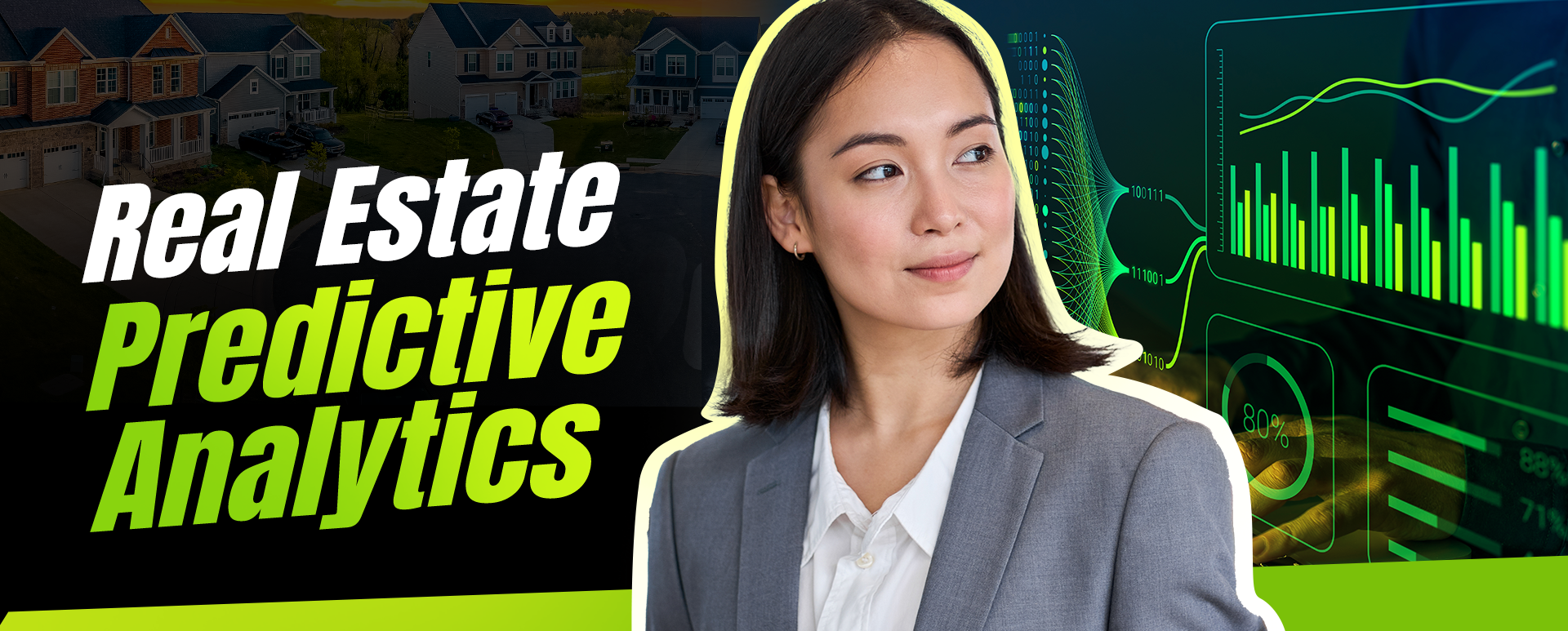Buying or selling a home is an enormous investment filled with unpredictable variables.
Pricing, demand, ideal timing - all major guesswork for real estate agents.
But artificial intelligence now fuels next-level forecasting to pinpoint exact opportunities so you score listings and close deals ahead of competitors.
Predictive analytics takes real estate metrics far beyond glancing in the rearview mirror.
Revolutionary machine learning algorithms uncover what’s ahead for neighborhood pricing shifts, buyer and seller patterns, and future local developments.
By translating this real-time data and context into action, software perfectly pairs properties with buyers primed to purchase.The AI difference means going from gut feelings to guarantees.
Quantifying buyer preferences, modeling the probability of conversions, knowing which upgrades maximize offer prices.
This predictive edge spots the prime prospects to target and customizes each outreach for prompt responses.
Chapter 1: What Is Real Estate Predictive Analytics?
Real estate predictive analytics refers to various statistical and analytical techniques that identify patterns in data to predict future outcomes.
By analyzing current and historical data, machine learning algorithms can uncover relationships and trends that allow for accurate forecasting across the real estate sector.
As an overarching concept, predictive analytics is extremely broad.
Specific techniques like regression analysis and neural networks fall under the predictive analytics umbrella.
Each approach employs mathematical modeling in different ways to inform everything from investment decisions to property valuations.
Predictive analytics solutions are powered by three key capabilities working together:
Data Analysis: Collecting, cleaning, and organizing datasets
Statistical Modeling: Identifying influential variables and relationships between them
Machine Learning: Developing algorithms that can learn from data patterns to forecast future trends
By no means is it necessary to understand all of the nuances of the technology to use it, knowing how the sausage is made might lead to deeper insight on future use cases and other applications in your sphere and niche.Following so far?
All of this is to say that these core competencies feed into a wide spectrum of real estate-focused applications. A few major areas where predictive analytics makes an impact include:
Market Trends: Spotting emerging trends across metro areas, price ranges, property types, demographics
Property Valuations: Estimating property values based on physical, neighborhood, and market features
Investment Opportunities: Pinpointing hidden opportunities and forecasting expected returns
Risk Assessments: Evaluating risk factors from cash flow variability to investment liquidity
Using mathematical and statistical approaches, predictive analytics empowers professionals to unlock granular insights from the volumes of data involved in real estate transactions and markets.
Chapter 2: Why Is Predictive Analytics Important for Real Estate?
The real estate sector deals in high-value assets influenced by countless variables.
Keeping up with even current market dynamics is challenging enough without trying to anticipate future shifts.
Predictive analytics serves as an indispensable tool for real estate professionals to gain an information edge.
By revealing invisible patterns and behaviors, it enables professionals to:
Forecast More Accurately: Predict price changes, buyer demand, neighborhood growth, job impacts, and more
Identify New Opportunities: Discover hidden investment prospects and commercial developments earlier than competitors
Mitigate Risk Exposure: Gauge cash flow variability, defaults risk, and other variables across portfolios
Optimize Marketing Initiatives: Craft targeted outreach to the most promising prospects and areas
Automate Valuations: Develop pricing models for more efficient valuations at scale
The commercial importance of predictive analytics will only increase as real estate data proliferation continues.
As the landscape becomes more complex, those who can translate data into strategic foresight will gain a distinct competitive advantage.
Chapter 3: Real Estate Areas Where Predictive Analytics Offers Value
Now that we’ve covered the real estate predictive analytics basics, let’s explore some specific use cases where this technology drives major value.
Residential Brokerages: Identify likely sellers earlier based on consumer patterns, estimate home values to inform listing prices, target likely buyers with tailored outreach, inform staging recommendations based on buyer preferences
Commercial Brokerages: Anticipate tenant turnover rates, determine optimal pricing for unit vacancies, identify ideal locations for planned developments, assess the impact of new transportation projects
Property Managers: Forecast tenant defaults, estimate necessary maintenance budgets, minimize collection loss risk across properties
Institutional Investors: Pinpoint emerging high-yield markets across metros and neighborhoods, model expected returns for potential acquisitions, predict median cap rates to inform bids and pricing
Developers: Evaluate risks across potential projects, model new construction impacts on the surrounding neighborhood, track buyer preferences to optimize planned community features
Assessors: Access granular, up-to-date valuations across entire real estate markets rather than relying on manual sampling and appraisals
Agents: Understand individual consumer motivations and preferences to enable more personalized service, identify likely sellers and buyers to create customized nurture campaigns, highlight strengths of listings accurately to relevant consumers
The applications here just scratch the surface of how professionals across residential, commercial, investing, development, and more can tap into predictive analytics.
Not only does this technology inform operational decisions – it becomes indispensable during negotiations where information symmetry means everything.By leveraging predictive insights, professionals gain an essential edge in real estate’s constantly shifting landscape.
But activating this data to drive value depends upon identifying the right tools and solutions.
MaverickRE:
The data-driven real estate platform that skyrockets your business through predictability, efficiency and control.
Chapter 4: Key Features of Top Real Estate Predictive Analytics Solutions
With use cases and advantages clearly demonstrated, exactly how can professionals implement predictive analytics into their real estate operations?
Here we’ll highlight must-have features and functionalities to look for when evaluating options:
Data Aggregation Capabilities
The analytics can only be as robust as the data behind it. Look for automated data centralization from disparate sources like assessments, listings, and consumer patterns.
AI and Machine Learning Integration
The solution should leverage artificial intelligence and machine learning, enabling algorithms to uncover hidden insights that even experts may miss.
Customizable Statistical Modeling
Flexible modeling options account for influences like seasonality, one-time events, and distinct regional considerations.
Actionable Visualizations
Interactive dashboards and clear visualizations allow professionals to act on insights quickly rather than sorting through endless spreadsheets.
Scenario Testing
The ability to evaluate different scenarios, from economic shifts to neighborhood developments, provides a complete picture of potential risks and opportunities
Automated Reporting
Schedule reports, projections, and predictive model updates to feed directly into operational decision-making workflows rather than one-off analytics requests.
Cloud-Based Access
A SaaS solution ensures scalability, accessibility for remote teams, and keeps pace with the newest algorithm innovations.
Identifying a predictive analytics solution robust across these requirements ensures you can realize value from these investments – without getting bogged down by implementation barriers.
Chapter 5: How Ylopo Unlocks the Potential of Real Estate Data
Ylopo offers an end-to-end, AI-powered platform combining predictive analytics, lead engagement tools, business intelligence, and digital marketing.
With integrated data infrastructure and analytics, Ylopo provides complete visibility into consumer behavior and market patterns. This activates your real estate data to uncover hidden opportunities and forecast trends.
A few predictive analytics capabilities available through Ylopo include:
Lead Intelligence: Identifies the most promising leads based on consumer patterns to focus nurturing efforts through automated systems
Consumer Journey Modeling: Maps the path potential buyers take from initial interest to closing – distinguishing serious prospects
Time-on-Market Projections: Leverages listing and macroeconomic data to estimate expected time-on-market for accurate pricing
Buyer Matching Engine: Matches listings to consumers who fit predicted preferences, budget, timeline, and priorities
Market Growth Projections: Predicts price changes, new construction growth, demographic shifts across neighborhoods
These predictive insights feed directly into the operational tools optimizing marketing and lead engagement powered by AI like the conversational bot Ylopo AI (formerly rAIya).
With visibility through the entire consumer journey, teams close more deals through highly personalized experiences.Ylopo provides you end-to-end functionality with predictive analytics fueling automated operational efficiencies across top-of-funnel lead capture to bottom-of-funnel consumer nurturing workflows.
This ensures professionals realize the full ROI from predictive analytics rather than getting stuck at the reporting stage.
Ylopo AI Text:
The pioneering 24/7 AI real estate assistant that actively converts leads 365 days a year.
Chapter 6: Other Predictive Analytics Tools for Real Estate
Many user-friendly predictive analytics tools exist to help real estate professionals harness their data:
Smartzip uses AI to analyze historical data, market trends, and homeowner information to predict which properties within specified geographic "farming" areas are most likely to be listed for sale. It focuses on generating seller leads that may require longer nurturing timelines.
Offrs leverages the same Smart Data platform as Smartzip but with unique ad tools to automate marketing and nurturing of non-exclusive leads. This includes email campaigns and calls through the Offrs Roof referral system which provides support in exchange for a 25% referral fee.
Catalyze AI combines real-time and historical data, behavioral analytics, and event-driven insights to predict which homes will sell. It specializes in uncovering inherited properties and offers exclusive, hyperlocal leads within a 20-mile radius. Pricing is based on property value under a unique two-tier model.
HouseCanary uses AI to analyze market demand, rental values, macroeconomic trends and other external data points across over 18,000 US zip codes. This powers accurate and granular property valuation and forecasting to assist real estate professionals in making data-driven investment decisions.
Likely.AI focuses specifically on identifying distressed sellers through predictive scoring and contact monitoring technology. It also integrates directly with CRMs to enrich data and inform better-targeted marketing and sales strategies. The tool additionally includes AI content creation features like ChatGPT for communications.
Unlock Your Real Estate Potential with Predictive Analytics
Predictive analytics represents a seismic shift for real estate professionals.
Transitioning from reactive to proactive operations unlocks game-changing advantages.
But simply adopting predictive analytics tools is not enough.
To fully capitalize, teams must incorporate these insights into workflows at every step.
Consumer data, buying signals, and market shifts inform how listing prices get set, which homeowners get targeted, what creative assets get produced, and how sales pitches get framed.Operationalizing predictive insights is equally important as generating them.
Additionally, predictive analytics does not diminish the need for market expertise.
If anything, it amplifies experience as the human perspective provides critical context for interpreting data patterns.
Combining machine and human intelligence ensures professionals separate signal from noise as they evaluate indicator variables and make strategic decisions.
Unlock Your Real Estate Empire with Ylopo's Proven Tech Stack
New year, new market domination strategy.
Leave the competition in 2024’s dust with Ylopo's real estate empire-building tech.
Our battle-tested industry experts poured 50+ years of insider expertise into proprietary algorithms that smash lead gen records.
We arm top producers like yourself with bleeding-edge predictive analytics, AI marketing automation, and premium lead conversion tools for unstoppable growth.
Become the hyperlocal market tyrant you’ve always envisioned. Let’s start strategizing your market monopoly today!









